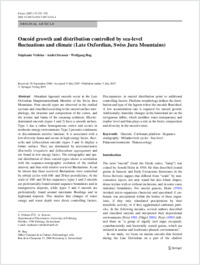Oncoid growth and distribution controlled by sea-level fluctuations and climate (Late Oxfordian, Swiss Jura Mountains)
- Védrine, Stéphanie Department of Geosciences, University of Fribourg, Switzerland
- Strasser, André Department of Geosciences, University of Fribourg, Switzerland -
- Hug, Wolfgang Office Cantonal de la Culture, Paléontologie A16, Porrentruy, Switzerland
-
2007
Published in:
- Facies. - 2007, vol. 53, no. 4, p. 535-552
oncoids
carbonate platform
sequence stratigraphy
Milankovitch cycles
sea level
palaeoenvironments
palaeoecology
English
Abundant lagoonal oncoids occur in the Late Oxfordian Hauptmumienbank Member of the Swiss Jura Mountains. Four oncoid types are observed in the studied sections and classified according to the oncoid surface morphology, the structure and composition of the cortex, and the texture and fauna of the encasing sediment. Micrite-dominated oncoids (types 1 and 2) have a smooth surface. Type 1 has a rather homogeneous cortex and occurs in moderate-energy environments. Type 2 presents continuous or discontinuous micritic laminae. It is associated with a low-diversity fauna and occurs in high-energy facies. Bacinella and Lithocodium oncoids (types 3 and 4) display a lobate surface. They are dominated by microencrusters (Bacinella irregularis and Lithocodium aggregatum) and are found in low-energy facies. The stratigraphic and spatial distribution of these oncoid types shows a correlation with the sequence-stratigraphic evolution of the studied interval, and thus with relative sea-level fluctuations. It can be shown that these sea-level fluctuations were controlled by orbital cycles with 100- and 20-kyr periodicities. At the scale of 100- and 20-kyr sequences, types 1 and 2 oncoids are preferentially found around sequence boundaries and in transgressive deposits, while types 3 and 4 oncoids are preferentially found around maximum floodings and in highstand deposits. This implies that changes of water energy and water depth were direct controlling factors. Discrepancies in oncoid distribution point to additional controlling factors. Platform morphology defines the distribution and type of the lagoon where the oncoids flourished. A low accumulation rate is required for oncoid growth. Additionally, humidity changes in the hinterland act on the terrigenous influx, which modifies water transparency and trophic level and thus plays a role in the biotic composition and diversity in the oncoid cortex.
- Faculty
- Faculté des sciences et de médecine
- Department
- Département de Géosciences
- Language
-
- English
- Classification
- Geology
- License
-
License undefined
- Identifiers
-
- RERO DOC 8365
- DOI 10.1007/s10347-007-0114-4
- Persistent URL
- https://folia.unifr.ch/unifr/documents/300539
Statistics
Document views: 128
File downloads:
- Document: 205
